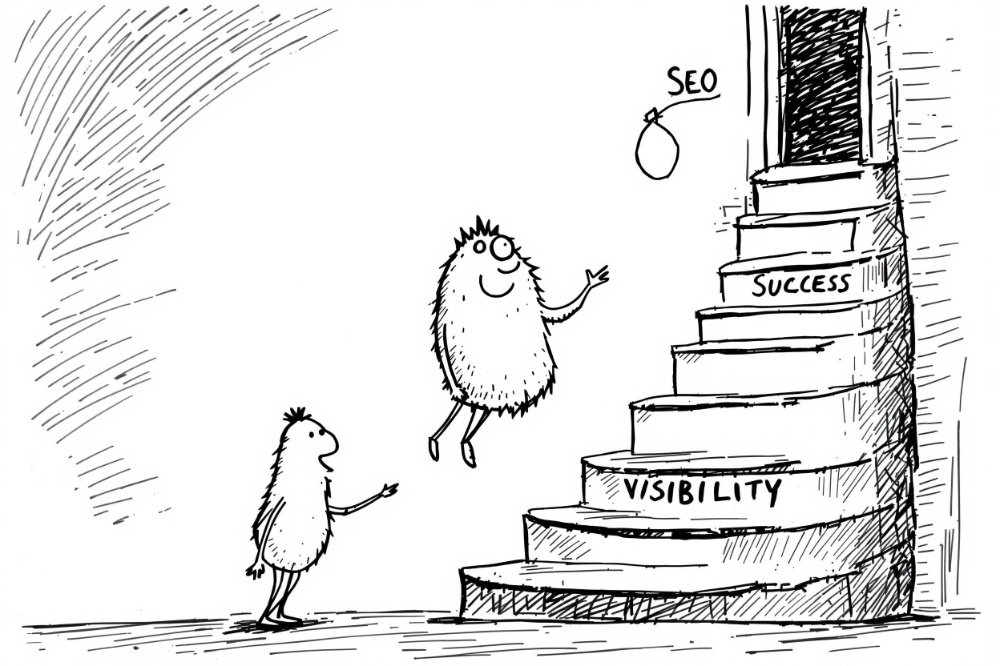Have you ever launched a fancy new career page only to find it buried somewhere under your Aunt Martha’s homemade cookie recipe in Google search results? Trust me, you’re not alone. The quest for better visibility can feel like hunting for a mythical creature—somewhere between a three-horned unicorn and a lost city of gold. Yet here we are, armed with laptops, coffee, and a dash of optimism, ready to tackle the big hairy monster known as Career Site SEO.
Getting your job postings noticed is half the battle. The other half is convincing job seekers to stick around once they actually land on your site. But fear not, dear friend. We’ll explore what it really means to improve your career site’s SEO, from the subtle art of sprinkling the right keywords to the high-stakes game of user experience. Along the way, we’ll crack a few jokes, highlight some critical strategies, and maybe, just maybe, help you avoid meltdown moments that prompt you to yell at your cat at 3 a.m.
Grab your beverage of choice and let’s dive in…

“Who Even Needs This SEO Thing Anyway?”
Good question. The short answer: everyone who wants talented, awesome humans to find their job listings without an expensive billboard in Times Square.
The internet is a crowded place. According to some fancy estimates, 75% of candidates begin their job hunt online. So if your career site is basically the digital version of a black hole—pulling in no one, releasing nothing—then guess what? Your dream candidate is heading to your competition’s site, or to that random aggregator that lumps your opening alongside 300 other “Entry-Level Wizards” positions.
SEO is the difference between being a needle lost in a million haystacks or shining bright like a disco ball on top of the hay.
And since you’re presumably not a fan of tumbleweeds blowing across your job postings, let’s get your site the attention it deserves.
The Brutal (And Hilarious) Cost of Ignoring Career Site SEO
Picture a majestic tall ship setting sail to find treasure, except the map is old, the compass is broken, and there’s a hole in the hull. That’s your career site without SEO. Dramatic? Perhaps. True? Definitely.
- Wasted Budget: You invest time and money creating job posts, talking up your sweet company perks, and adding friendly pictures of your rescue office goldfish. But nobody sees any of it if your pages rank on page 17 of a Google search.
- Lost Candidates: The world’s best developer might be out there, sipping coffee, typing in “innovative startup data engineer job near me.” If your site doesn’t pop up quickly, they apply elsewhere. Opportunity missed, folks!
- Frustrated Recruiters: Your team can only wrangle so many passive candidates on LinkedIn. Without organic traffic coming in, their metaphorical fishing poles are reeling in fewer and fewer catches.
- Brand Damage: If your career site is non-existent in search, people might wonder, “Does this place even exist? Are they that company operating out of the back of a donut shop?” Not exactly a confidence-booster.
Ignoring SEO is like ignoring a squeaky brake on your car—it’s only a matter of time before there’s a crash. You want your top-notch openings discovered easily, not hidden under digital cobwebs.
Start With The Basics: Keywords, But Make Them Smart
Ever watch a cooking show where the chef says something like, “Always taste as you cook”? Keywords are kind of like that. You don’t just dump in random words like “ninja rockstar synergy” and hope for the best. You use relevant, specific keywords that real people actually type when searching for jobs.
Brainstorm Candidate-Focused Keywords
Think about the roles you’re hiring for: “Java Developer in Chicago,” “Marketing Coordinator—Remote,” “Accountant with QuickBooks experience.” These are more specific than “career,” “job,” or “work.” Use tools like Google Keyword Planner or SEMrush to see what’s trending.
Pro Tip: Focus on long-tail keywords. They’re less competitive and bring in more targeted traffic.Sprinkle Them Strategically
Don’t stuff your pages like you’re trying to hide every Thanksgiving leftover in your fridge at once. Add keywords naturally in titles, meta descriptions, headings, and in the body text. The idea is to help Google (and humans!) figure out quickly what the job is about.Local SEO Goodies
If your roles are location-based, add local flair to your keywords. “Sales Manager in Denver” can do wonders. Also, set up or optimize your Google My Business listing—contrary to popular belief, it’s not just for pizza joints. GMB signals can boost your local SEO if you have physical offices.
Yes, you can embed job listings from Indeed or other boards, but it’s vital to optimize them on your site, too. If not, you’re just handing traffic to someone else.
Why Content Quality Matters More Than a Thousand Random Keywords
Let me guess: the hiring manager wrote a 37-paragraph job description that reads like an IKEA instruction manual, right? Or maybe it’s a single line that says, “We need a dev. Apply now.” Both approaches are, shall we say, less than ideal.
The Google and Human Connection
Search engines value quality content. So do humans. If your job descriptions look like a Shakespearean tragedy or a cryptic puzzle, you lose readers. If it’s too bare-bones, Google shrugs. The sweet spot is a thorough, engaging job post that includes all essential details while hooking the candidate’s interest.
It’s not rocket science:
- Describe responsibilities clearly.
- Outline the perks without sounding like you’re bribing them.
- Summarize your company culture.
Make a Resource Hub
Another approach is to build a mini content library around the roles, your industry, and the application process. Blog posts on “How to Shine in a Sales Interview” or “What to Expect During Our Onboarding Process” help job seekers. This isn’t just about funneling candidates—regularly updated blog content also signals to search engines that your site is alive and kicking. Plus, it shows you care about job seekers enough to provide helpful resources. Gold star for you!
When you craft content that answers real questions, you invite more relevant, organic traffic.

Technical SEO: The Nerdy Stuff That Actually Counts
If content and keywords are the bread and butter, technical SEO is the jam. For the uninitiated, this includes anything from page load speed to mobile responsiveness to structured data markup. Think of it as the behind-the-scenes wizardry that keeps search engines from having a meltdown when they crawl your site.
1. Mobile-Friendliness
We live in an era where job seekers apply while sipping coffee, riding the train, or ignoring their cat’s pleas for attention. If your site isn’t mobile-friendly, people bounce faster than you can say “404 error.” Google also now uses mobile-first indexing, so a site that’s clunky on a phone basically waves a sad white flag in search rankings.
2. Speed Matters
Page speed is crucial. If it takes longer to load your site than it does to brew instant coffee, you’re in trouble. Tools like Google’s PageSpeed Insights can help. Candidates are busy—they won’t wait around for slow pages. And guess what? Neither will Google’s rankings.
Think of it this way: a slow-loading site is like a bouncer at a club who checks every ID in excruciating detail—nobody has time for that, so they find another party next door.
3. Structured Data
Job postings can benefit big-time from schema markup. By adding structured data, you help search engines display your job listings more prominently. This can lead to neat little enhancements like job details right in the search results.
It’s like wearing a giant sign that says, “Hey Google, we have real, legit job postings. Show us some love!”
4. Keep the Bots Happy
Use an XML sitemap and a clean site architecture. Don’t make search engine crawlers navigate a labyrinth worthy of a minotaur. If your site has a million subpages scattered across 14 subdomains, it’s time to simplify. A good structure means you can funnel visitors to relevant pages easily. This keeps your users, and Google’s little robot armies, very, very happy.
User Experience: Because No One Likes a Maze
Ever stroll into a carnival funhouse, walking into mirrors, tripping over illusions? A small portion is fun, but after about 30 seconds, you’re done. That’s exactly what an overcomplicated career site feels like to potential candidates. Except they don’t even get cotton candy.
A good user experience (UX) can boost conversions significantly. If a candidate can’t find your “Apply” button or figure out which roles are open in the Denver office, they’ll bail. Here’s how to avoid turning your site into a labyrinth:
- Clear Navigation: Use obvious menu labels. If you have a million pages, group them logically.
- Easy Filters: Let candidates filter roles by location, department, or role type. Because nobody wants to scroll through 256 irrelevant job postings.
- Concise Application Forms: Don’t ask for a DNA sample. Keep it short and sweet, or risk scaring people off.
User metrics like dwell time, bounce rate, and pages per session speak volumes. If you keep them engaged, you show search engines your site is relevant. Everyone wins.
Building Trust Through Social Proof and Testimonials
Let’s do a quick experiment: who do you trust more, a restaurant that has zero reviews or one that’s recommended by two of your friends and a local critic? Exactly. People want social proof. They want to see real employees or job seekers vouching for your company.
- Employee Testimonials: Add quotes or short videos featuring real employees. Keep it authentic; no cheesy scripts.
- Glassdoor & Indeed Reviews: You can’t micromanage external reviews, but you can direct candidates to see them. If you have good standing, flaunt it. If not, fix it, because it’s out there anyway.
- Case Studies: If you placed a candidate who went from zero to hero in your company’s ladder, tell that story. People love real-life success tales.
Trust equates to higher candidate confidence. Confidence equates to more applications. It’s the circle of recruiting life, folks.

Avoiding SEO Pitfalls That Make Search Engines Hiss
Like a moody cat, search engines can hiss at shady behavior. If you’re too cunning, it backfires. Here’s what to avoid:
- Keyword Stuffing: Repeating “UI Developer Boston UI Developer Boston UI Developer Boston” is about as subtle as an elephant in a library.
- Duplicate Content: Copying job descriptions from other sites or from your own pages repeatedly is a big no-no.
- Cloaking: Hiding keywords in invisible text is like gluing a “Kick Me” sign on your own back. Google will eventually find out.
- Weird Backlinks: Don’t buy 1,000 shady backlinks from the “Buy SEO Now” site. Bad SEO karma awaits.
Think of search engines like polite dinner guests: treat them right, and they’ll reward you. Trick them, and they’ll show you the door.
Building a Content Calendar for Long-Term Wins
SEO isn’t a “one-and-done” deal. It’s like a garden—continual planting, watering, weeding. One great technique is a content calendar focusing on:
- Seasonal hiring trends (“End-of-Year Finance Openings,” “Summer Internships”)
- Industry news or insights related to your roles
- Employee spotlights (“Meet Sarah, Our UX Whisperer”)
- Application tips or interviews with the hiring manager
Regular updates signal Google that your site isn’t lying dormant. More content equals more indexed pages, which equals more ways to be found. Just ensure each piece is relevant and well-crafted. Nobody wants to read random fluff about your company’s favorite pizza toppings. Actually… that might be interesting if done humorously, but proceed with caution.
Getting Analytical: The Smart Way to Track Success
Think of analytics as your treasure map. Without it, you’re steering blindly. Tools like Google Analytics and Search Console show how people find you, what keywords lead to your pages, and whether they do a 5-second cameo or actually hang around. This data helps you refine your approach.
- Bounce Rate: If it’s high, folks might not be finding what they need.
- Time on Page: A measure of engagement. Are your job descriptions interesting enough?
- Conversion Rate: The ultimate success metric: how many visitors apply for a job?
Compare these numbers regularly. Tweak content, adjust keywords, streamline navigation, and watch the metrics shift. It’s not rocket science, but it’s definitely more fun than a science fair volcano that erupts soggy baking soda all over the floor.
Machine Hiring: Your BFF for Data-Driven Recruiting
Now, let’s talk about a tool that can give you a serious leg up. Machine Hiring (yes, that’s us) is an AI-powered Applicant Tracking System (ATS) that not only helps you manage your candidates but also ensures your job postings are optimized for search. Seriously. It tracks metrics, suggests improvements, and can even parse massive volumes of resumes without batting a digital eyelash.
We know that the real superpower in recruitment is combining automation with human insights. So we built Machine Hiring with features like:
- Smart Candidate Matching: Our AI reads job descriptions and filters the best candidates. You just sit there, sipping coffee, feeling important.
- Bulk Parsing: Upload a folder full of resumes, watch them get sorted automatically. Magic? Possibly.
- Searchable Talent Pools: Every candidate is neatly stored and easily searched later. So no more rummaging in email attachments from 2022.
- Analytics and Reporting: Crisp dashboards show how your postings perform, from click-through to application rate.
You want synergy between your career site and your ATS. That’s where the magic happens, folks.
The Power of Collaboration: Getting All Hands on Deck
SEO for your career site doesn’t have to be a lonely quest. Roping in marketing, HR, IT, and your pet hamster might be beneficial too. Ok, maybe not the hamster. But definitely cross-pollinate ideas:
- Marketing: They know brand voice and SEO from a marketing standpoint. Use that.
- HR/Recruitment: They know what job seekers are asking for.
- IT/Developers: They can fix site speed issues, integrate new tools, handle structured data markup.
When everyone unites, you get a cohesive, turbo-charged approach. It’s like a synchronized swimming team, but for websites.
Building Backlinks (The Right Way)
Yes, inbound links from reputable sites help your SEO. But spamming blog comment sections from 2009? No. Instead:
- Guest Posts: Write helpful articles for reputable HR or industry blogs. Link back to your career page.
- Universities: Sponsor events or internship programs. They might link to your job postings from their career portals.
- Professional Associations: Partnerships can yield valuable links as well.
Keep it above-board, relevant, and valuable. Quality trumps quantity in the link-building game.
Evolving SEO Tactics (Because the Game Always Changes)
Search engine algorithms are like the weather in some regions: unpredictable, occasionally ridiculous. That’s why you keep monitoring trends.
- Voice Search: People increasingly say, “Hey Google, find me a marketing job near me.” Adjust your keywords and site structure accordingly.
- AI in SEO: Tools that analyze your content or auto-generate meta descriptions can be huge time-savers.
- User Intent: Not everyone visiting your site wants the same thing. Understand intent, tailor the content.
Stick to best practices, stay agile, and don’t panic every time Google updates its algorithm. A solid foundation rarely gets toppled.
Building a Talent Community for Long-Term Gains
One final gem of wisdom: capture the visitors you do get. Even if they don’t apply immediately, they might in the future. Offer newsletter sign-ups for job alerts, or create a “Talent Network” where they can upload a resume for later consideration. This fosters a loyal audience that returns to your site.
Remember, SEO helps with the discovery, but retention is all about how you engage folks afterward. That’s why building an ongoing talent community is so powerful. People see your brand, trust your content, and eventually apply when the timing is right.
Bringing It All Together
Whew! We’ve covered a lot—like a buffet of everything from the whimsical to the deeply technical. Here’s a lightning recap:
- Solid Keywords: Relevant, long-tail, location-specific.
- Quality Content: Engaging job descriptions, helpful resources, updated blogs.
- Technical SEO: Speed, mobile-friendliness, site structure, schema markup.
- User Experience: Easy navigation, short forms, filter-friendly job listings.
- Ongoing Updates: Content calendars, analytics reviews, continuous refinement.
- Trust and Collaboration: Social proof, internal teamwork, and ethical backlink strategies.
- Adopt Tools That Help: Like Machine Hiring for data-driven recruiting.
- Watch Out For Pitfalls: Don’t get blacklisted for spammy tactics.
SEO for your career site is not just about search engines—it’s about people. Make it easy for the best candidates to find and engage with your openings, and you’ll reap the rewards.
A personal note: I’ve seen companies hire rockstars thanks to a well-structured, optimized career site. I’ve also seen the ones that skip SEO altogether and wonder where all the good candidates have gone. Don’t be that latter group. The internet is chaotic, but with the right strategy, you can stand out.
A Quick Shoutout
By the way, if you’re ready to transform your entire hiring process—not just the SEO part—there’s a free trial from Machine Hiring that might be your new best friend. Because, let’s face it, who doesn’t love a tool that automates the boring bits so you can focus on the fun stuff?
Related Posts
- The Psychology of Job Descriptions: How AI Can Help Write Better Job Posts
- Transform Your Candidate Experience: A Modern Recruiter’s Guide
- Remote Hiring Playbook: Building High-Performing Distributed Teams
- The Hidden ROI of Employee Onboarding: Why Your First 90 Days Make or Break Success
- Forget Coding—Can You Communicate? Why Soft Skills are the New Hard Skills


